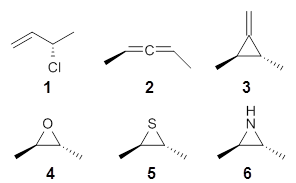What is the appropriate basis set to use for computing optical rotations? Hedgård, Jensen, and Kongsted examined the optical rotation of 1-6 using B3LYP and CAM-B3LYP at two different wavelengths.1 They examined a series of different basis sets, including the aug-pCS sets2 (developed for NMR computations), the aug-cc-pVXZ series and 6-311++G(3df,3pd). They compared the computed optical rotation with the different basis sets with the value obtained from an extrapolated basis set computation. The mean absolute deviation using either B3LYP or CAM-B3LYP at the two different basis sets are listed in Table 1. The bottom line is that aug-pcS-2 is the preferred method, but this basis set is rather large and computations of big molecules will be difficult. The aug-pcS-1 set is the best choice for large molecules. Errors with the extensive Pople basis set and the aug-cc-pVXZ sets are quite sizable and of concern (especially at the shorter wavelength). It should also be mentioned that even with the largest aug-pcS basis sets extrapolated to the CBS limit, the computed value of the optical rotation of 3 has the wrong sign! Clearly, basis set choice is not the only issue of concern. We remain in need of a robust methodology for computing optical activity.

Table 1. Mean absolute deviation of the optical activities of 1-6 evaluated at two wavelengths.
|
|
589.3 nm |
355.0 nm |
||
|
Basis set |
B3LYP |
CAM-B3LYP |
B3LYP |
CAM-B3LYP |
|
aug-pcS-1 |
4.5 |
2.2 |
20.8 |
15.3 |
|
aug-pcS-2 |
1.4 |
1.1 |
4.0 |
1.5 |
|
aug-cc-pVDZ |
15.6 |
13.6 |
62.2 |
144.1 |
|
aug-cc-pVTZ |
3.9 |
6.3 |
9.2 |
37.0 |
|
6-311++G(3df,3pd) |
6.4 |
10.3 |
20.5 |
40.7 |
References
(1) Hedegård, E. D.; Jensen, F.; Kongsted, J. "Basis Set Recommendations for DFT Calculations of Gas-Phase Optical Rotation at Different Wavelengths," J. Chem. Theory Comput. 2012, 8, 4425-4433, DOI: 10.1021/ct300359s
(2) Jensen, F. "Basis Set Convergence of Nuclear Magnetic Shielding Constants Calculated by Density Functional Methods," J. Chem. Theory Comput. 2008, 4, 719-727, DOI: 10.1021/ct800013z

Henry Rzepa responded on 30 Mar 2013 at 11:23 am #
You write Steve that “we remain in need of a robust methodology for computing optical activity”. An equal, if not bigger problem is dealing with molecules which exist in several conformations. It is often the case that two conformers can exhibit opposite rotations! In which case the observed rotation will be the weighted average of )all) the conformations. This is a tough one to compute reliably.
In our hands we have often had to resort to the ultimate technique, vibrational circular dichroism. It does not depend on electronic excitations (which can so often be a problem), and in one spectrum one often will have 5-10 vibrations on which to base a conclusion. In other words, it is the fit to ALL the vibrations that turns out so much more reliable than just a single measured value.
Since a vibrational spectrum can be obtained at close to 0K (as a thin film), one can also dispense with solvent and such an ultra low temperature has another advantage. It reduces the Boltzmann distribution of conformers compared to that at room temperatures, perhaps even to just one conformation. I would predict in fact that in ten years time, the majority of assignments of absolute configuration will be done using either thin-film (or solution) VCD or anomalous X-ray and that optical rotation (along with electronic circular dichroism) will become rare.
Feist’s acid. Stereochemistry galore. « Henry Rzepa responded on 04 Apr 2013 at 9:32 am #
[…] of methylenecylopropane (1, with Me replaced by CO2H). Compound 1 itself is nowadays is used to calibrate chiroptical calculations.[1], which is what brought it to my attention. But about four decades ago, and now largely […]